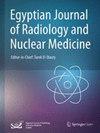聚焦超声的神经学应用:临床和研究趋势介绍与更新
IF 0.5
Q4 RADIOLOGY, NUCLEAR MEDICINE & MEDICAL IMAGING
Egyptian Journal of Radiology and Nuclear Medicine
Pub Date : 2024-08-28
DOI:10.1186/s43055-024-01338-4
引用次数: 0
摘要
聚焦超声已成为一种非侵入性技术,具有治疗各种疾病,尤其是神经系统疾病的潜力。本文旨在探讨利用聚焦超声治疗神经系统疾病的最新进展。文章通过全面的文献综述,探讨了聚焦超声目前的临床应用和研究用途,旨在提供该领域的最新进展概况。通过采用不同的强度和频率组合,聚焦超声可与软组织产生多种相互作用,包括组织消融、空化和机械效应。高强度聚焦超声可用于组织消融,并已获得 FDA 批准用于治疗药物难治性本质性震颤。相反,低强度聚焦超声则用于神经调控和打开血脑屏障,促进药物输送以治疗脑肿瘤和其他神经系统疾病。本文回顾了正在进行的研究聚焦超声在神经系统疾病治疗中作用的临床试验。聚焦超声在控制和治疗各种神经系统疾病方面大有可为。无论是用于组织消融,还是瞬时打开血脑屏障以加强药物输送,都有许多潜在的应用。有必要开展进一步研究,以评估其安全性,并将临床结果与标准疗法进行比较。本文章由计算机程序翻译,如有差异,请以英文原文为准。
Neurological applications of focused ultrasound: an introduction and update on clinical and research trends
Focused ultrasound has emerged as a non-invasive technology with potential for treating various medical conditions, particularly neurological diseases. This article aims to explore recent advancements in the utilization of focused ultrasound for treating neurological conditions. A comprehensive literature review was conducted to explore current clinical applications and investigational uses of focused ultrasound, aiming to provide an up-todate overview of the field's progress. By employing different combinations of intensity and frequency, focused ultrasound can induce diverse interactions with soft tissues, including tissue ablation, cavitation, and mechanical effects. High-intensity focused ultrasound is utilized for tissue ablation and has received FDA approval for treating medication-refractory essential tremor. Conversely, low-intensity focused ultrasound is employed for neuromodulation and opening the blood–brain barrier, facilitating enhanced drug delivery for treating brain tumors and other neurological conditions. This article reviews ongoing clinical trials investigating focused ultrasound's role in neurological condition treatment. Focused ultrasound holds significant promise for managing and treating various neurologic conditions. Whether employed for tissue ablation or transiently opening the blood–brain barrier to enhance drug delivery, numerous potential applications exist. Further research is necessary to evaluate its safe implementation and compare clinical outcomes with standard-of-care therapies.
求助全文
通过发布文献求助,成功后即可免费获取论文全文。
去求助
来源期刊

Egyptian Journal of Radiology and Nuclear Medicine
Medicine-Radiology, Nuclear Medicine and Imaging
CiteScore
1.70
自引率
10.00%
发文量
233
审稿时长
27 weeks
 求助内容:
求助内容: 应助结果提醒方式:
应助结果提醒方式:


